From the Archives: A Public Beach in a Natural Area
Part Three: A War of Words
By Labor Day, 2005, supporters and opponents of a beach in the Natural Area had hardened their positions and frustration was in the air. Frustration would soon turn to harsh words.
DRED’s statements about costs and responsibilities made it clear a beach in the Natural Area would not be the inexpensive proposition town officials had presented to voters in March.
Letters about costs appeared in the Carroll County Independent, and the newspaper itself questioned the expense, reminding the Select Board that the town already faced unbudgeted expenses of up to $250,000 annually to comply with new environmental regulations for the town incinerator.
If there were financial doubts at Town Hall, however, they didn’t show. The mood there was optimistic, with Selectman and State Representative Harry Merrow calling concerns about the beach “premature,” and expressing doubts that the impact studies would produce anything to stop the development project. Pressing ahead, the town hired The Nature Conservancy to begin work on the required plant inventory.

Select Board member Joe Skehan conceded the town beach on Duncan Lake was little used. Merrow disagreed. Alliance Photo
Meanwhile, opponents of the beach began peppering state officials with questions. Ossipee Lake Alliance publicly asked DRED why it thought Ossipee needed a gift of state land for a beach when the town already had two underutilized public beaches and access to near-by White Lake State Park.
Seemingly surprised by the question, DRED threw it to Merrow, who said swimming at the town’s Constitution Park shorefront was prohibited by the Marine Patrol, and White Lake was overcrowded and often turned away beachgoers on busy weekends. State officials quickly shot down both of Merrow’s claims.
As for the town beach on Duncan Lake, Select Board member Joe Skehan conceded that “very few people use it” after reviewing pictures showing the beach with only a handful of people on a hot August Saturday. Merrow, who was not at the meeting, later said he disagreed with Skehan’s assessment.
Tempers flared. The Carroll County Independent published an aerial photo of hundreds of boaters at the Natural Area site and quoted Merrow asking “How come they [opponents of his plan] are so concerned about us using the beach when they [the opponents] don’t do anything about those people?” [meaning the boaters].
In response, Ossipee Lake Alliance’s David Smith pointed to the irony of a State Representative asking why local lake and conservation organizations had failed to solve a long-standing, well-documented state problem.
“Instead of working with the lake community and environmental groups on a solution, Merrow spent much of last year in private negotiations with [DRED Commissioner] Bald’s successor to bring more people to the site,” Smith said.

Controversy followed after Harry Merrow posted this picture and caption in a prominent location in Town Hall. Contributed Photo
The aerial photo caused further friction after Merrow taped it to a Town Hall door with the caption: “This is the beach that some do not want the townspeople to use for fear they will damage the plants.”
Bob McDonald of Long Sands Association called the act gratuitously divisive. Addressing Merrow directly, he demanded equal time to post pictures of “other pet projects you have sponsored, such as Constitution Park Beach, to illustrate the town’s poor track record in maintaining public recreational areas.”
Merrow eventually took the picture down and said he had only posted it for the benefit of people who didn’t know where the Natural Area was. But the reference to Constitution Park had hit a nerve.
Constitution Park abuts the Long Sands residential community and has wetlands, a small pond, sports fields and walking trails to the lake. It was the result of hundreds of hours of volunteer work, but in 2005 it was a mess.
Interpretive signs were broken or missing, boardwalk support posts were rotted, and ATVs raced around the property at night. Abutting property owner and Conservation Commission member Jean Hansen took pictures of the damage and submitted them to the Select Board.
From there, the pictures made their way to the Carroll County Independent, where they sparked an editorial scolding of the Select Board about its responsibilities. Not lost on anyone was that town officials had been using Constitution Park as evidence to DRED that it could manage the Natural Area.

In addition to vandalized signs and rotted boardwalk posts, Constitution Park was used as a dump for debris. Contributed Photo
With tension still in the air, the town released the initial plant survey in late October. The report said the beach site was a regionally rare sandy pondshore community system containing five distinct natural communities, four of which were rare in New Hampshire, and one of which was the state’s only known example. Also found at the site was the endangered plant species Euthamia caroliniana.
Opponents of the beach said the report validated DRED’s 1999 decision to prohibit development of the site. Merrow called the report inconclusive.
“You can read it three or four times and not be sure what it means,” he said, adding that a plant community that is rare in New Hampshire might not necessarily be rare in another state.
He said further research was needed, and recommended that the Select Board proceed with the second phase of the plant inventory in the spring.
As boaters left the lake and the holidays approached, the Carroll County Independent named the beach-in-a-natural area its “story of the year.” But in a matter of weeks, that story would be over and a new chapter would begin for the beleaguered property.
Next: A new governor changes everything.

Wow, the comment that Merrow only put the picture on the door to show people where Long Sands was located is like Justice Samuel Altio saying that it was his wife who put up the American flag flying upside down!!!!!! Harry give us a break.
Even though I was an active member of the committee appointed by the State for roughly 20 years………reading the first two parts of this story has given me many new details and insights into this issue. Thanks David for putting this piece together for people to see.